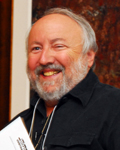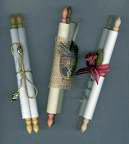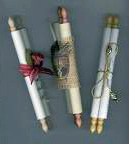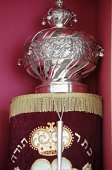INTRODUCTION
This is a study of
the Transfiguration of Yeshua (Jesus) and its significance.
The Transfiguration of Jesus is found in three Gospels:
Matthew 17:1-8, Mark 9:2-8, and Luke 9:28-36. To get the
full picture of what happened, all three Gospel accounts
must be studied and compared.
I. THE
OBSERVERS
First, concerning the
ones who observed the Transfiguration, it was not all twelve
disciples but only three: Peter, James and John. Just prior
to this experience Yeshua promised His disciples that some
of them would not die until they saw His glory in the
Kingdom. In Matthew 16:28, the promise Jesus made that,
some of them that stand here would
not die until they saw the glory of the Son of man coming in
his kingdom was now fulfilled, and the some were
Peter, James and John. These were the some who saw the
Transfiguration.
Furthermore, they went unto a very high mountain. Just
before this event they were in Caesarea Philippi at the foot
of Mount Hermon. So we take this mountain not to be Mount
Tabor, which is the traditional sight of the
Transfiguration, but rather Mount Hermon, the highest
mountain in all of the Holy Land, being over 9,000 feet
above sea level. As they came to a very high mountain, the
Transfiguration occurred.
II. THE TRANSFIGURATION
The three Gospel accounts
of the Transfiguration read as follows:
Matthew 17:2: ... and he was
transfigured before them; and his face did shine as the sun,
and his garments became white as the light.
Mark 9:3: ... and his garments
became glistering, exceeding white, so as no fuller on earth
can whiten them.
Luke 9:29: And as he was praying,
the fashion of his countenance was altered, and his raiment
became white and dazzling.
In the Transfiguration, a transformation took place and
suddenly a very bright light penetrated through the body of
Yeshua, lighting up and whitening His clothes. What they saw
was indeed the glory that the Son of Man will have in His
Kingdom; they saw the Shechinah Glory itself. Throughout
eternity past, Jesus had always been characterized by this
very glory. But when Jesus became a man at the incarnation,
the Shechinah Glory—the glory of the Messiah—was veiled by
His human body. Only at one point in His life on earth did
the Shechinah Glory penetrate through the physical frame of
His body, and that was at the Transfiguration. When the
Transfiguration occurred, it was the out-shining of the
glory of God. The veiled-glory was unveiled for a few
moments before these disciples.
III. MOSES AND ELIJAH
Along with Yeshua, there
were two other men from the Old Testament: Moses and Elijah.
Why were these two men present and not others? There are two
reasons. First, Moses was there to represent the Law, and
Elijah was there to represent the Prophets. Remember,
that the purpose of the coming of Yeshua was to fulfill the
Law and the Prophets. In fact, Luke 9:30b-31 states:
... Moses and Elijah; who appeared
in glory, and spoke of his decease which he was about to
accomplish at Jerusalem.
The Greek word for “decease” is exodos. It is the
Greek word from which our English word “exodus” is derived
and some Bibles translate the word as “departure”. In other
words, the topic of conversation among Jesus, Moses and
Elijah was the coming death of Jesus in
Jerusalem. Since the death of Jesus was the fulfillment of
the Law and the Prophets, that is one reason why Moses and
Elijah happened to be there.
The second reason why these two men were there was that
Moses had died but Elijah had not. Moses was there to
represent the saints that will be resurrected. Elijah was
there to represent the saints that will be translated or
changed into immortal beings at the point of the Rapture,
without having to go through the process of death. These
saints will change in “the twinkling of an eye” while they
are still living.
The fact that the term exodos is used is significant.
The Exodus of Israel from Egypt meant freedom and
liberation. The reason for discussing His death—His
exodos—might be for three additional reasons.
First, His death and coming resurrection would mean freedom
for Yeshua from all limitations, for when Yeshua became a
man, He was limited in His use of divine power. In fact,
even His glory was no longer visible because it was veiled,
and was exposed only in these few moments. Yeshua’s death
would mean freedom from all the limitations imposed by the
Incarnation.
Second, it would free Him from living in a world of sin.
Jesus once said, How long must I
bear with you; how long must I bear with this wicked
generation?” The holy Person of Yeshua having to
live and walk among sinful men was always something that
weighed heavily upon Him. His decease—His exodos—would
indeed be a point of freedom for Him.
Finally, the exodos of Jesus would free the believer
from bondage to sin.
IV. THE RESPONSE OF
PETER
At this point Peter
entered into the conversation and said in Matthew 17:4:
And Peter answered, and said unto
Jesus, Lord, it is good
for us to be here: if you will, I will make here three
tabernacles; one for you, and one for Moses, and one for
Elijah.
At this point Peter interrupted the conversation of the
three men and suggested that he be allowed to build three
tabernacles: one for Yeshua, one for Moses, and one for
Elijah. In many, many sermons on this passage, Peter is very
often castigated for the specific sin of
wanting to put Yeshua on the same level with Moses and
Elijah. By wanting to build three tabernacles instead of
just one, some claim it meant that either Peter was
elevating Moses and Elijah to be on a par with Jesus, or he
was demoting Yeshua to be on the level of Moses and Elijah.
However, that is not a correct interpretation of this
passage.
Just before the Transfiguration, Peter was the one who said:
You are the Messiah, the Son of the
God, the Living One (Mat. 16:16). Peter clearly
knew who Jesus was and he knew the Messiah was superior to
both Moses and Elijah. He was not trying to put Jesus on
equal par with the others or vice versa. Rather, this is a
proper response, but Peter’s timing was wrong.
Remember what Peter was seeing. He had seen the glory that
the Son of Man will have in His Kingdom. Peter knew from
Zechariah 14 that the Feast of Tabernacles was going to be
fulfilled by the Messianic Kingdom. That is why, during the
Messianic Kingdom, it will be
obligatory for all to observe the Feast of Tabernacles.
Preceding the experience, it is clear that Peter did not yet
understand the program of death and resurrection. Now he was
seeing the glory that Yeshua would have in the Kingdom and
he expected that the Kingdom to be established at this time.
He expected the Feast of Tabernacles to be fulfilled at this
time, and that is why he wanted to build the three
tabernacles.
But because he did not yet understand the program of death
and resurrection, he did not yet understand that the Feast
of Passover had to be fulfilled before the Feast of
Tabernacles could be fulfilled. So his response is not
wrong; it was a proper response based upon the
knowledge he had at that point and the truth, as he
understood it. Although it was a proper response, his timing
was totally wrong. For that reason, he was not allowed to
build the three tabernacles, because it was Passover that
Yeshua came to fulfill and not the Feast of
Tabernacles. Therefore, in keeping with the promise of
Yeshua, Peter saw the glory that the Messiah will have in
His Kingdom.
V. THE
GLORY CLOUD
Matthew 17:5 records what
happened next: While he was yet speaking, behold, a bright
cloud overshadowed them: and behold, a voice out of the
cloud, saying, This is my beloved
Son, in whom I am well pleased; hear ye him.
Suddenly the words of Peter were interrupted by the glory
cloud descending upon Mount Hermon and taking in all three
men. The glory cloud came down, and God the Father spoke
audibly from amidst this cloud. Three times in the ministry
of Jesus, God the Father spoke audibly from heaven. The
first time was at His baptism (Mat. 3:17); second, at His
Transfiguration; third, at the end of His ministry (Jn.
12:28).
This is the second time God the Father spoke audibly from
heaven saying: ... This is my
beloved Son, ...
This is the Messiah.
Here, God the Father affirmed that which Peter had just
recently confessed in Matthew 16:16 when he said,
You are the Messiah, the Son of the
God, the Living One.
Then God the Father said: ... in
whom I am well pleased; ... Because Jesus
fulfilled the will of the Father.
Thirdly, God the Father said: ...
hear ye him.
They had heard the Law. They had heard the Prophets. Now
they must listen to the Son, because the Son is the final
revelation. That is the point of Hebrews 1:1-3, where the
writer pointed out how, in past
times, God has revealed Himself in various ways and divers
portions, but has, in these last days revealed Himself in
his Son. They must hear, listen, and obey the
Son.
The cloud overshadowed all three men and, at that point,
the disciples no longer saw the three men. They saw only the
cloud and heard the voice of God the Father saying:
This is my beloved Son in whom I am
well pleased; hear ye him.
Then, in Matthew 17:8, as if to drive home that same point,
suddenly the cloud lifted: And
lifting up their eyes, they saw no one, save Jesus only.
The purpose of seeing only Jesus was to drive home the point
that He was the One they had to hear. They had heard the
Law; they had heard the Prophets, now they had to hear the
Son.
VI.
THE SIGNIFICANCE OF THE TRANSFIGURATION
There are theological
significances of the Transfiguration that should be
carefully noted. First, the Transfiguration authenticated
the Messiahship of Yeshua, which had been rejected by men
but accepted by God. When God the Father spoke audibly, He
said,
This is my beloved Son in whom I am
well pleased, hear ye him. This authenticated the
Messiahship of Yeshua.
Secondly, the Transfiguration anticipated the earthly
Kingdom of the Messiah. This is seen in two ways. First,
before the Transfiguration Jesus promised His disciples that
some of them would not die until they saw the glory that the
Son of Man would have in the Kingdom
(Mat. 16:28). The some who did not die were Peter, James and
John. When they saw the Transfiguration, they saw the glory
that the Son of Man will have in the Kingdom. Thus, it
anticipated the coming earthly Kingdom.
One of these three men, Peter, later wrote these particular
words in II Peter 1:16-18:
| For
we did not follow cunningly devised fables, when we
made known unto you the power and coming of our Lord
Jesus Christ, but we were eyewitnesses of his
majesty. For he received from God the Father honor
and glory, when there was borne such a voice to him
by the Majestic Glory, This is my beloved Son, in
whom I am well pleased: and this voice we ourselves
heard borne out of heaven, when we were with him in
the holy mount. |
When Peter reflected on
the experience, he pointed out that, to him, it was an
anticipation of the future power and coming of the Lord
Jesus Christ; the coming of the Messiah in His Kingdom.
The third significance of the Transfiguration is that it
guarantees the fulfillment of all prophecies; it guarantees
the fulfillment of all Scriptures. This is also seen in two
ways. First, according to Luke 9:31, the discussion which
Yeshua had with Moses and Elijah concerned His coming
exodos—His coming death, which would fulfill the Law and
the Prophets. Secondly, the eyewitness of this event, Peter,
wrote in II Peter 1:19-21:
| And
we have the word of prophecy made more sure;
whereunto ye do well that ye take heed, as unto a
lamp shining in a dark place, until the day dawn,
and the day-star arise in your hearts: knowing this
first, that no prophecy of scripture is of private
interpretation. For no prophecy ever came by the
will of man: but men spoke from God, being moved by
the Holy Spirit. |
Again, from the
background of the Transfiguration, Peter took this as
evidence of the guarantee of the fulfillment of all
Scripture.
The fourth significance of the Transfiguration is that it
contains a pledge of the life beyond. Both Moses and Elijah
were there. Moses did die, so he represented the resurrected
saints. Elijah did not die, so he represented the translated
saints. There is this pledge of the life beyond. The fact
that these two men continue to exist, though one in
spirit-form only, and the other in a glorified-body form who
was translated, and yet were still present and able to
communicate, shows the continuation of the life beyond
death.
The fifth significance of the Transfiguration tells us what
it cost Jesus to come. It meant He had to veil His glory
twice. The first time His glory was veiled was at the
Incarnation. Then, at the Transfiguration, the Shechinah
Glory penetrated through the veil; but after the
Transfiguration, it was veiled for a second time. What did
it cost Yeshua to come? It meant He had to veil His glory
twice.
Finally, the Transfiguration shows the measure of His love;
He was willing to do all this on our behalf.
*
RECOMMENDED READING
If you enjoyed this Bible study, Dr. Fruchtenbaum recommends the
following messianic Bible studies (mbs):
mbs 009: The Trial of the Messiah
mbs 016: Nicodemus, A Rabbi's Quest
mbs 020: How Did the Wise Men Know? or Is Astrology Valid?
mbs
028: The Olivet Discourse
mbs 031: Highlights of the Birth and Early Life of Jesus
mbs 032: The Baptism and Temptation of Jesus
mbs 035: The Three Messianic Miracles
mbs 036: The Three Sabbath Controversies Between Jesus and
the Pharisees
mbs 040: The Parables of the Kingdom
mbs 043: The Confession of Peter
mbs 048: Mammon of Unrighteousness
mbs 049: The Adulterous Woman
mbs 056: The Triumphal Entry
mbs 060: The Upper Room Discourses
mbs 061: The High Priestly Prayer of Jesus
mbs 069: The Agony of Gethsemane
mbs 070: The Death and Burial of the Messiah
mbs 075: The Resurrection of the Messiah
mbs 076: The Ascension of the Messiah
mbs 094: The Sermon on the Mount
mbs 099: The Results of the Death of Messiah
mbs 127: The Birth and Early Life of the Messiah
mbs 134: How the New Testament Quotes the Old Testament
mbs 183: The Healing of the Man at the Pool of Bethesda:
John 5
mbs 185: Jesus and the Samaritan Woman: John 4:1-42
Many of Dr. Fruchtenbaum's studies are available for free online
reading and
listening at Ariel Ministries'
Come and See. All of his materials are
available for purchase at Ariel Ministries in various
formats.
Other select materials and resources are
available at Ariel, as well.
|
Arnold G. Fruchtenbaum, Th.M, Ph.D.,
is founder and director of Ariel Ministries.
|



